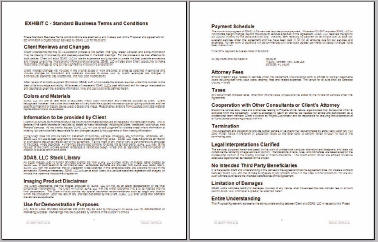APPENDIX H
The Professional Services Agreement

IN THE 3D VISUALIZATION INDUSTRY, few would probably question the importance of a contract between themselves and a client. It doesn’t take much time on any of the popular 3D forums to see that most members strongly support the use of a contract of some type, even for projects with which the client is well-known and highly respected. However, the reason why a contract is so important might not be so commonly understood.
Contracts in any industry serve one obvious purpose of providing legal protection, whereby either party can be afforded the opportunity to pursue legal action to recover financial damages. Ironically, this legal protection is not at all what makes a contract so invaluable for most projects in our industry. In an ideal world, having a good contract in place would mean that regardless of a project’s size, we can all sleep soundly knowing that if things unravel between us and the client, we can recover our losses with the help of our local legal systems. Unfortunately, we don’t live in an ideal world and the reality is that while all of us will be victim to unscrupulous clients from time to time, it is unlikely that many of us will ever recover damages through legal channels.
Except for very large projects where a tremendous amount of money is involved, few of us can afford the legal expenses that arise by taking advantage of laws in place. In most cases, we realize that pursuing legal action is not worth the time, cost, or risk, whether we have a clear case or not. Despite having worked in this business for over ten years and discussing the matter countless times with peers, none of the partners at 3DAS has ever met an individual or company who has successfully recovered damages from a client.
What makes a contract so invaluable is not the legal protection it provides, but rather the information it provides. A well-written contract should make it clear beyond any reasonable doubt, what the responsibilities and expectations are of every party involved in a project. By making this information understood from the start, a properly worded contract should prevent a guilty party from deciding to fight in the wake of legal action, and prevent a project from spiraling out of control and forcing either party to pursue legal action in the first place. By taking the time to word a contract properly and review it with a client early on as necessary, you can avoid learning the hard way how small an amount of legal protection a contract provides.
Sample PSA
Included in the support files of this book is a sample contract, referred to as a Professional Services Agreement (PSA), which you can use as a template for the creation of your own contract. This PSA is comprised of 4 main sections; Authorization to Proceed, Scope of Services, Professional Fees, and Standard Terms and Conditions. The remainder of this appendix is a brief discussion of some of the most important areas of these three sections.
Introduction and Authorization to Proceed
This section of the PSA serves as an introduction and the location where both parties can sign to acknowledge acceptance and authorization to proceed. Besides the authorization to proceed, the most important highlight of this section is paragraph 1.a. where the client designates one representative as “the single individual whom has the authority to accept and/or approve services and invoices provided by 3DAS and to direct tasks per contract on behalf of the CLIENT or Owner.” For projects with numerous individuals involved on the client’s side, this is a very important designation to make. Without making it clear to everyone involved that one individual should serve as the approving authority for your services, your efforts to solicit information, critiques, and approval may have to be performed over and over again to different individuals. Making this designation early on can save a great deal of time and prevent awkward situations between you and the client.

Scope of Services
Exhibit A, Scope of Services, is without a doubt the most important part of the PSA. This section should answer in great detail the who, what, when, where, how, and why of your project. The information provided in this section should make it clear to the client, without question, exactly what he or she can expect throughout the course of the project. There is no one most important part of this exhibit, because all of it is critical and equally important. It is comprised of 3 parts; Description of Services, Final Product, and Project Schedule.
Description of Services
Many clients understand very little about the 3D design process and exactly what they are getting themselves into. If you do not spell out what you will be providing in great detail, you are likely to see complications arise later on when the client realizes that his or her expectations were not met. Notice in paragraph 1.a.1 of the sample PSA, that precise details regarding animation length are included as well as comments such as “Virtual elements of the animation will be limited to those elements lying within the boundaries of the property.” It is extremely important that both parties know exactly how long an animation will be or that nothing outside the boundary of the project’s property lines will be shown; or, least created in 3D.
Included in the description of services should be details about which rooms will be visible for interior sequences and which areas of the property will be visible for exterior sequences. Without these details, clients will too often ask you to add a bathroom, foyer, lanai, etc. to the animation sequence without really understanding the enormity of what they are asking.
Most of the details outlined in the scope of services should be mentioned to some extent during the first sales pitch you make to a client. One of these details that should be driven home over and over again is mentioned in paragraph 1.a.4. Here we make it clear to the client that every detail shown in the project’s elevations will be modeled and shown in 3D. We mention this from the first meeting with a client, informing him that as 3D artists we make the presumption that if an architectural feature is important enough to be seen in an elevation, it is also important enough to be see in 3D. Likewise, if it’s not important enough to be drawn in the elevations, then it is not important enough to be modeled in 3D. For example, if the client provides us elevations that don’t include door knobs, we cannot be responsible for providing such a detail in 3D and may elect to charge additionally for such details if the client decides later on that it is necessary.
Also discussed in this section are details regarding the resolution of still imagery provided. Many clients don’t understand the significance of pixel resolution and may later ask you why their image looks so bad when it’s blown up to fit a 8’x4’ billboard. Addressing the maximum resolution you are providing may prevent such a question later on.
The last section of the description of services addresses the all-important issue about modifications and post-production. You should use every opportunity available to ensure that the client understands what he or she can change without incurring additional costs and the exact details regarding how draft renderings are presented and how often they are presented. Notice in paragraph 1.c.1 that we inform the client that the very first test render that will be presented will be a black and white image or animation without materials or colors applied. The sole purpose of the initial test-render is to allow the client to identify design issues or modeling errors. By excluding colors and materials, you allow the client to focus on what is really important early on; providing approval of the 3D models.
Final Product
The very first question you should always ask a client during the first discussion of a project, unless the client has already provided the information, is “What is the final product?” Without knowing the answer to this question, everything else discussed is a moot point. This section of the PSA simply addresses this issue in precise detail. If the client wants something more than a standard T.V. resolution or something more than the typical still-image resolution you provide, reading this section should make it clear that he or she needs to ask.
Project Schedule
This section of the PSA serves two purposes. It specifies what you provide the client and when, and identifies what the client needs to provide you before you can begin your work. It is critically important to identify in the contract exactly what the client needs to provide to you in order for you to start and complete your work, because if a project gets off schedule and fingers are pointed, having made your needs clear from the start can keep you from being blamed.
Notice in paragraph 3.b, that completion of the various stages of the production process are not specified in hard dates but rather in days from the completion of a previous phase. This is very important, because if you tell the client for example that you will provide the first draft renderings by a certain calendar date and miss the date because you got a late start as a result of not having all the information you needed, then you might have no one to blame but yourself.
Professional Fees
By listing all fees on one page, as shown in Exhibit B of the sample PSA, you can make it very easy for the client to understand what is being charged and that there are no hidden fees buried elsewhere in the contract. Doing this also makes it possible for you to send your employees or subs the scope of services without revealing the details of the project’s finances. Providing copies of the scope of services to all the individuals working on a project makes it just as clear to your production personnel exactly what needs to be done, as it does to your client.
Notice in paragraph 1.c that an hourly fee is billed for additional services not included in the scope of services. Since most of the profit from a project would come from the total fee outlined in paragraph 1.a, it might be beneficial for your hourly fee to reflect a lower value than what you really budget. In other words, if you decide that to be profitable you need to charge X per hour and you determine that 100 hours of work are needed to complete the project, you can simply make your total fee 100X. However, if you state your hourly fee as less than X, you will not make as much on changes but the client will assume that your total cost will be based on the hourly rate, and therefore, that more hours are involved in the project and he or she is receiving a greater value. Since the amount of time spent on changes is usually small relative to the total hours of a project, using this technique is usually beneficial.
Standard Terms and Conditions
Every business that uses contracts should have standard terms and conditions, and in the 3D visualization business, the terms and conditions identified in Exhibit C of the sample contract should provide adequate protection against unforeseen issues.

Two areas of particular importance are mentioned at the beginning of this exhibit; Client Reviews and Changes and Colors and Materials. They convey to the client that our work is just as much an art as it is a science. As such, they must understand that things like colors, lighting, and interpretation of non-specific data will never be perfect. Specifically it states,
• 3DAS will use its best effort to accurately match color information and materials provided by client. Client recognizes, however, that colors and materials will vary from the supplied information due to lighting conditions and the specific printer and/or display device used to display the image. Reasonable variations from supplied color data material representation are to be expected.
• Client understands that the 3D visualization process is not perfect, that “gray areas” will exist, and some information may be missing if not clearly and precisely specified in the CAD drawings. For the process to be cost-effective for both parties, Client will allow 3DAS to use its experience and judgment to create the best possible animations and images given time, financial and informational constraints. 3DAS will also allow Client opportunity to make reasonable changes as long as they significantly improve the presentation.


